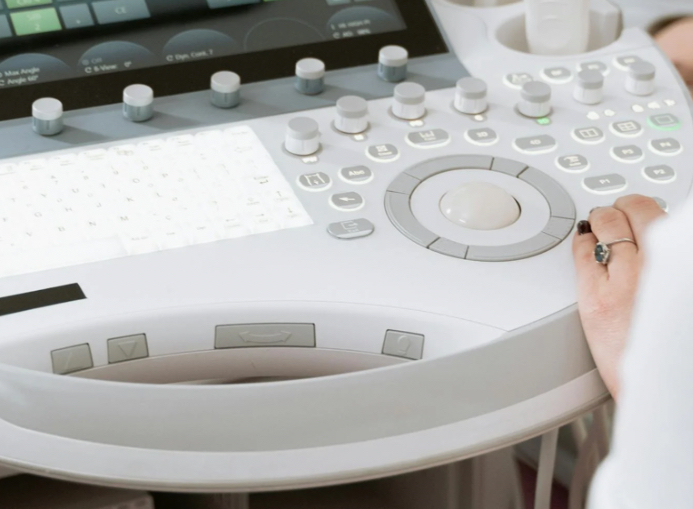Radiofrequency ablation (RFA) is recognized as a minimally invasive, effective treatment for managing uterine fibroids, particularly in women who wish to preserve their uterus. Despite its widespread application and benefits, including minimal patient discomfort and low complication rates, RFA is not without risks. This article explores the adverse outcomes associated with RFA, highlighting a case of a rectouterine fistula, a rare but serious complication.
Case Presentation: Rectouterine Fistula Post-RFA
We present a unique case of a 36-year-old woman experiencing persistent dysmenorrhea and lower back pain after conservative fibroid treatment. Subsequent RFA of an intramural fibroid resulted in a rectouterine fistula, identified by symptomatic bloody anal discharge and vaginal leakage of stool. This condition required surgical intervention, including a rectal fistula wedge resection and total abdominal hysterectomy, due to severe uterine cavity inflammation and necrosis. This is, to our knowledge, the first reported instance of such a complication following RFA treatment in the presence of pelvic endometriosis.
Discussion: Assessing Risks and Complications of RFA
While RFA is generally safe, its capacity to induce severe thermal injuries to adjacent organs warrants careful consideration. The formation of fistulas, although rare, underscores the importance of thorough pre-procedural counseling and careful operative monitoring. This case emphasizes the necessity for surgeons to remain cognizant of the potential for thermal damage, particularly in patients with complex pelvic conditions like endometriosis or significant adhesions.
Comprehensive Review of Literature on RFA Complications
A review of existing literature reveals that while minor complications such as abdominal pain and discharge are common, severe adverse outcomes like fistula formation are exceedingly rare but can have profound implications. This section contrasts our case with previously reported complications of RFA in other organs, discussing the clinical management and outcomes of such instances. Moreover, it explores the implications of RFA on future pregnancies, highlighting the need for cautious patient selection and detailed risk-benefit analysis.
Comparative Table: RFA vs. Alternative Fibroid Treatments
| Treatment Method | Efficacy | Complication Rate | Impact on Fertility |
|---|---|---|---|
| RFA | High | Low to moderate | Potentially impacts future pregnancies |
| Myomectomy | High | Moderate | Generally preserves fertility |
| Uterine Artery Embolization | Moderate to high | Moderate | Uncertain impact on fertility |
| Hysterectomy | Definitive | Low (post-surgical) | Eliminates fertility |
This comprehensive analysis of RFA’s application in uterine fibroid management provides valuable insights into its safety profile, reinforcing the need for individualized patient care and informed consent processes.
Essential Considerations for RFA in Uterine Fibroids
- Patient Selection: Careful evaluation of the patient’s medical history, fibroid characteristics, and reproductive desires;
- Informed Consent: Comprehensive discussion of potential benefits, risks, including rare complications such as rectouterine fistula;
- Pre-Treatment Assessment: Detailed imaging and investigations to map fibroid location and assess for pelvic pathologies like endometriosis;
- Procedure Planning: Tailoring the RFA approach to minimize risk to adjacent organs, especially in cases with extensive adhesions or endometriosis;
- Post-Treatment Monitoring: Close follow-up for early detection of complications and management of symptoms, ensuring timely intervention if needed.
Integrating RFA into Multidisciplinary Fibroid Management
The introduction of Radiofrequency Ablation (RFA) as a treatment for uterine fibroids has revolutionized conservative management strategies. This technique, lauded for its minimally invasive nature, offers a blend of efficacy and safety appealing to both clinicians and patients desiring uterine preservation. The success of RFA lies not only in its ability to reduce fibroid volume and alleviate symptoms but also in its integration into a broader, multidisciplinary approach to fibroid management. This approach encompasses a thorough patient selection process, emphasizing the importance of individualized treatment plans that consider the patient’s symptomatic relief, reproductive aspirations, and the presence of co-existing pelvic conditions like endometriosis.
Moreover, the evolution of RFA highlights the critical role of advanced imaging techniques in guiding treatment. Laparoscopic ultrasound guidance has enhanced the precision of fibroid targeting, minimizing the risk of injury to surrounding tissues and optimizing treatment outcomes. The collaboration between radiologists, gynecologists, and fertility specialists ensures comprehensive care, from pre-treatment evaluation to post-procedure follow-up. Such teamwork is pivotal in navigating the complexities of fibroid treatment, maximizing benefits while safeguarding patient health and future fertility.
Future Directions in RFA Research and Application
As the first case of a rectouterine fistula following RFA of a uterine fibroid underscores, there remains a frontier of exploration to enhance the safety and effectiveness of this treatment modality. Future research endeavors must focus on refining patient selection criteria, developing real-time monitoring technologies during RFA, and advancing techniques to prevent thermal damage to adjacent organs. Investigating the long-term outcomes of RFA, particularly concerning fertility and pregnancy, is essential to provide comprehensive counseling to women of reproductive age.
Moreover, the advent of robotic assistance in laparoscopic procedures presents an exciting avenue for increasing the precision and safety of RFA. The integration of robotic systems could potentially offer better control and visualization during the treatment of fibroids, especially those located in challenging positions or within a complex pelvic environment. As we advance, the goal remains to enhance the therapeutic arsenal against uterine fibroids with RFA, ensuring it remains at the forefront of minimally invasive, uterus-sparing treatments. Through continued innovation and rigorous clinical evaluation, the potential of RFA can be fully realized, offering hope and improved quality of life to countless women worldwide.
Conclusion
The occurrence of a rectouterine fistula post-RFA underscores the critical balance between therapeutic benefits and potential risks. As RFA continues to be a preferred conservative treatment for uterine fibroids, healthcare providers must engage in meticulous procedural planning and execution. This includes considering the patient’s reproductive desires and thoroughly discussing possible complications. Future research and clinical guidelines are essential for enhancing the safety and efficacy of RFA, particularly for women contemplating pregnancy.



